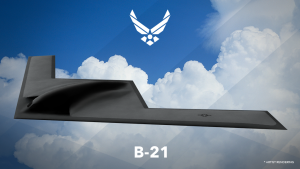Jacob Parakilas

It was recently reported that the first two copies of the U.S. Air Force’s first new bomber in a quarter century, the B-21 Raider, are nearly ready to begin flight testing. No one outside the classified world has yet seen a B-21, but thanks to renderings released by the Air Force and the plane’s manufacturer, Northrop Grumman, we have a pretty good idea what it looks like: a flying wing or, in other words, a slightly smaller, slightly less complex-looking cousin of the existing B-2 Spirit.
Flying wings are one of the rarest and most exotic types of aircraft in operational service, and even so, their basic design is not new. The Raider’s distant ancestor, the YB-35, first flew shortly after the end of World War II; its design was itself based on aerodynamic research dating back to the first years of the 20th century, only a few years after the very beginning of powered flight itself.
Aircraft, it seems, increasingly resemble one another. It takes a moderately serious observer to be able to distinguish between an F-16, a Eurofighter Typhoon, or a J-10 at a glance; it takes a significantly more serious observer to be able to do so between an Airbus and a Boeing. And the similarities are not just apparent in aircraft: armored fighting vehicles, warships, missiles, and even military uniforms and body armor are increasingly alike in appearance and basic design (if, admittedly, not in technical detail and theory of employment).
Even categories of military technology that seem novel, like UAVs, are actually refinements – admittedly massive ones – rather than a wholly new innovation. The first “drone” was tested by the United States toward the end of World War I, while remotely piloted aircraft were used operationally from WWII onward. Nor are the aerodynamic designs of drones particularly novel; the ubiquitous quadrotor form of smaller drones was first used by the de Bothezat helicopter – aka the “Flying Octopus” – of 1923. (The Flying Octopus was a failure; quadrotors are aerodynamically more efficient at much smaller scale. Sometimes an innovation of form comes along decades before its enabling technologies are ready.)
To be clear, innovations of form are hardly the only type of innovation. A T-14 Armata tank may share a basic form with a World War II-era T-34, but in every meaningful respect it is an exponentially more sophisticated and capable system. The forms of the systems we have are the product of decades – sometimes centuries – of refinement; they continue to be used because they have proven themselves in the real world, not simply because of technological stagnation.
Fundamental innovation is, frankly, risky. Even where an innovation of form technically works, it is likely to operationally fail, or at best come to occupy a very specific niche. Military hydrofoils saw a brief moment in the sun in the 1960s and ‘70s, but the high running costs, staggering fuel consumption, and overall mechanical complexity were judged to be poor tradeoffs for an admittedly substantial boost in top speed relative to a conventional gunboat. Hovercraft have demonstrated their utility as landing craft, but other uses never materialized, leaving them the preserve of a small number of navies who have the requisite combination of sufficient funding and a strategic doctrine focused heavily on expeditionary operations. And while lighter-than-air craft are the subject of a round of “are blimps back?” articles every few years, the answer – frequently punctuated with a eye-catching accident – always seems to be “no.” That is not the kind of record that argues for replacing proven systems with unproven ones, even for non-combatant purposes.
To some extent, the similarities of form reflect a broader consolidation in defense technology. Weapons systems have been growing far more complex and expensive to develop and procure; at the same time, fewer and fewer companies are capable of managing their development and procurement. The countries that can afford to innovate generally have existing strategic interests to protect, which promotes a conservative approach to procurement. Smaller countries can still produce competitive systems, but the cost of programmatic failure for them is higher, which also promotes adherence to existing design forms.
Of course, part of the reason that novel forms continue to intrigue us is the awareness of the times in history that warfare was fundamentally changed by new forms of weapons. The machine gun transformed set-piece battlefield engagements into the protracted, grinding slaughterhouse of trench warfare; the tank and the airplane broke the supremacy of fixed defenses and inaugurated the era of rapid mobility and strategic shock that defines conventional warfare to this day. But those changes also came out of the febrile period around two of the most devastating wars in human history, fought in close succession. To those of us in peacetime or something like it, the idea of visibly, distinctively new wonder weapons is compelling – so compelling that it can blind us to the subtler shifts in underlying technology, doctrine, and other less visible changes, which have at least as much influence over how war is fought as something that looks different to its predecessor.
No comments:
Post a Comment